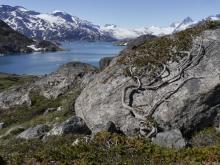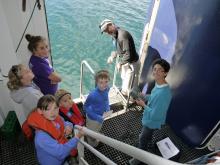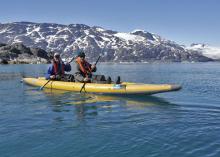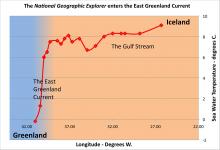What Are They Doing?
This joint U.S.-Canada research cruise used two icebreakers to collect data to identify the edge of the continental shelf in the Arctic Ocean. As needed, the Healy broke sea ice for the Louis S. St-Laurent, while it collected data to map the geology of the sub-seabed. Scientists aboard the Healy also measured seafloor bathymetry, collected high-resolution sub-seafloor data, made ice observations, collected water samples, and monitored marine mammals and ocean noise through high frequency audio recording.
Under the United Nations Convention on the Law of the Sea, the continental shelf is defined as the stretch of the seabed adjacent to the shores of a particular country. Information from the cruise helped each country determine where they have rights over the natural resources of the seafloor, which include mineral resources, petroleum resources such as oil and gas, and animals like clams and crabs.
To learn more about the science of the expedition, please visit the Extended Continental Shelf Project website. In addition to a PolarTREC teacher, Caroline Singler, a NOAA Teacher at Sea teacher was also aboard and you can follow her journals here.
Where Are They?
The team lived and worked from the United States Coast Guard Icebreaker Healy. The USCGC Healy is a research vessel designed to conduct a wide range of research activities and can break through 4 ½ feet of ice continuously. The research team boarded the ship in Dutch Harbor, Alaska, traversed the Bering, Beaufort, and Chukchi Seas and disembarked in Barrow, Alaska. The Healy will work in tandem with the Canadian Coast Guard Ship Louis S. St-Laurent.
Latest Journals

Helen Gibbons is a public information scientist at the U.S. Geological Survey (USGS) in Menlo Park, California. Ms. Gibbons works with USGS scientists around the country to publish informative articles about their coastal and ocean research in the monthly newsletter Sound Waves (http://soundwaves.usgs.gov/). She also helps researchers create written materials, displays, and hands-on activities for members of the general public interested in USGS science. She is looking forward to sharing ideas with the two teachers participating in the August 2010 Canada-U.S. joint Arctic expedition. Helen will serve as web coordinator for logs and images posted at the Continental Shelf Project Website (http://continentalshelf.gov/) before and during the expedition.

Jonathan Childs is a scientist at the U.S. Geological Survey (USGS) in Menlo Park, California. Mr. Childs scientific interests include using seismic reflection data to study and map the seafloor and studying the unique laws of the worlds oceans.

Brian is a sedimentologist with the USGS Pacific Coastal and Marine Science Center who will serve as Chief Scientist aboard Healy during the joint U.S.-Canada extended-continental-shelf survey in August. He brings to the job more than 30 years of sea-going experience on 60-plus coring and geophysical cruises along the west coast of the United States, the Ross Sea (Antarctica), the North Pacific Ocean, and the Bering Sea. Brian specializes in sedimentary processes and stratigraphy, integrating insights gleaned from seafloor rock and sediment samples with information from remote-mapping products, such as close-up photographs of the seafloor, high-resolution bathymetric maps, and seismic-reflection profiles (sound "slices" through the seafloor that create an image like rocks exposed on the walls of the Grand Canyon). His recent studies have focused on how sediment moves from the land to the deep sea, processes controlling submarine landslides, saltwater intrusion into coastal aquifer systems, marine pollution, and seafloor habitats.





